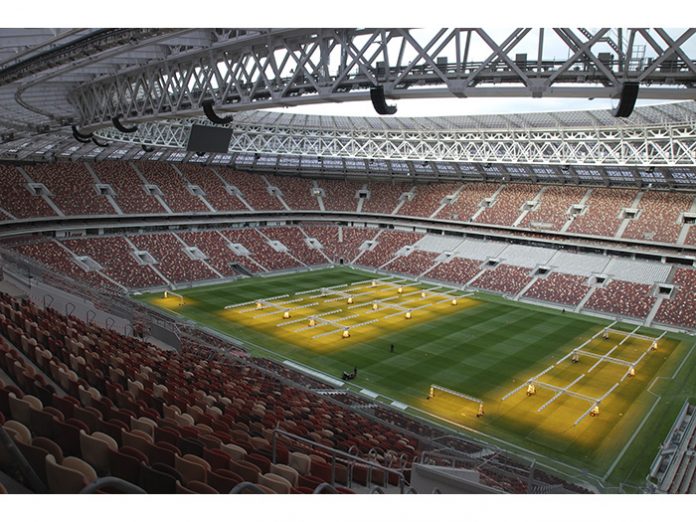When Moscow’s original Luzhniki Stadium was demolished in 2013 to give way for the construction of a new stadium, it was with the 2018 FIFA World Cup in mind. At the end of 2015 a new tender document was drawn up on behalf of the principals, The Big Sport Arena Luzhniki, for the 81,000 seat stadium, with the technological requirements detailed by Moscow integration specialists S-Pro Systems, together with the German company Broadcast Solution.
Selected by the Russia 2018 FIFA World Cup bid as the venue for the Final, the Stadium will also be used as a heritage venue after the Championship. At the heart of the new network broadcast transmission are some 57 Optocore and BroaMan fiber interfaces, designed in a fiber ‘star’ out of the ring topology, and supplied by Moscow-based distributor Audio Solutions. After the bid was accepted they became involved in the project as an S-Pro partner, with responsibility for equipment supply and warranty service management of the whole system.
They were able to demonstrate the advantages of producing a site-wide multi-node fiber transmission system and broadcast/multi-format links to the OB vans. According to Igor Kovalev, who manages Audio Solutions’ Pro Audio Department, “Optocore and BroaMan create a perfect synergy, providing an extremely robust optical network system for audio transport and auto routing functionality. Optocore I/O modules also have a wide working temperature range, which was one of the important criteria for choosing equipment for this project.”
The team responsible for the audio design comprised Andrey Matveev (S-Pro), Evgeniy Stepanenko (Broadcast Solution), Pavel Pyshkin (S-Pro) and Ivan Khizhnyak (S-Pro). S-Pro’s project managers were Sergey Manserov and Grigory Yurov. The Optocore system was designed around two main nodes: (1) Stadium patch panel room in OB Van area for multi-signal conversion to MADI. Various Optocore X6R-FX, X6R-TP V3R-FX and V3R-FX- TP converters were mainly fitted with MI (Mic-In) and LO (Line Out) cards, while an Optocore M8-BNC allows OB Van MADI connection with additional feature of Emulation Mode to control on-site Optocore mic preamps directly from the Van’s console. (2) Media control room, with a Yamaha 02R96 digital console equipped with an Optocore Y3R-TP Yamaha card — enabling it to work with Optocore’s proprietary SANE protocol.
Igor said the system had needed to meet a number of objectives: To uplink the environmental bowl sound (the stadium crowd noise), with the Optocore modules bundled in the technical racks positioned around the playing field perimeter; to integrate with the intercom systems of the technical personnel (achieved by using Optocore’s dedicated V3R-FX- INTERCOM); to integrate with the stadium’s sound reinforcement system; to integrate with the stadium’s patch panel room; to integrate with the stadium’s media room, which comprises all the multi-media signals, and finally to integrate with the commentator’s communication system.
With the Optocore systems widely distributed across the stadium, various tasks in terms of audio maintenance could be implemented with all events taking place (other than football matches). To expedite broadcast requirements Audio Solutions turned to Optocore’s associate company BroaMan, which in turn harnesses the power of Optocore. Two of the new Route66 AutoRouters are stacked, with each fiber node connected independently through the Route66. “The combination of redundancy and ability to close the Optocore loop automatically when active devices are added or disconnected, are the main advantages of the BroaMan Route66 AutoRouters,” stated Igor.
The installation also takes advantage of economies, for example the Optocore TP devices are separated and placed up to 50 meters above the main FX devices — resulting in the need for fewer FX devices and less fiber cabling. The system, which conforms to all worldwide broadcast standards, has certainly met the approval of The Big Sport Arena Luzhniki and Igor said that with the successful fulfillment of signal conversion and audio/data transport — with the delivery of pristine, low latency audio — all objectives have been met.
“The great advantage of an Optocore solution is that there is no interference from power cable runs, perfect EMR isolation and it has extremely flexible functionality, with the ability to handle any audio transport tasks with ease, over long distances,” he concluded.
www.optocore.com / www.broaman.com



